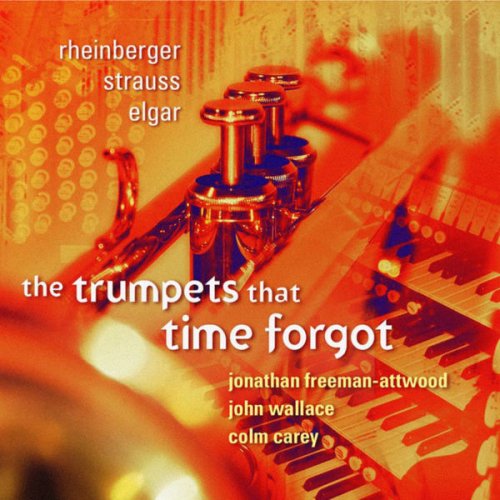
Jonathan Freeman-Attwood, John Wallace and Colm Carey - The Trumpets That Time Forgot (2004)
BAND/ARTIST: Jonathan Freeman-Attwood, John Wallace, Colm Carey
- Title: The Trumpets That Time Forgot
- Year Of Release: 2004
- Label: Linn Records
- Genre: Classical
- Quality: FLAC (tracks + booklet)
- Total Time: 59:12
- Total Size: 238 MB
- WebSite: Album Preview
Tracklist:
1. Suite for Two Trumpets and Organ, Op. 149: I. Con moto (08:54)
2. Suite for Two Trumpets and Organ, Op. 149: II. Thema mit Veränderungen (09:22)
3. Suite for Two Trumpets and Organ, Op. 149: III. Sarabande (11:32)
4. Suite for Two Trumpets and Organ, Op. 149: IV. Finale (07:00)
5. Three Movements from the Suite, Op. 60 "Le Bourgeois Gentilhomme": I. Minuet de Lully (02:18)
6. Three Movements from the Suite, Op. 60 "Le Bourgeois Gentilhomme": II. Courante (02:29)
7. Three Movements from the Suite, Op. 60 "Le Bourgeois Gentilhomme": III. Entrée de Cléonte (04:35)
8. Sonata No. 2, Op. 87a: I. Introduction (02:25)
9. Sonata No. 2, Op. 87a: II. Toccata (03:33)
10. Sonata No. 2, Op. 87a: III. Fugue (03:24)
11. Sonata No. 2, Op. 87a: IV. Coda (03:36)
1. Suite for Two Trumpets and Organ, Op. 149: I. Con moto (08:54)
2. Suite for Two Trumpets and Organ, Op. 149: II. Thema mit Veränderungen (09:22)
3. Suite for Two Trumpets and Organ, Op. 149: III. Sarabande (11:32)
4. Suite for Two Trumpets and Organ, Op. 149: IV. Finale (07:00)
5. Three Movements from the Suite, Op. 60 "Le Bourgeois Gentilhomme": I. Minuet de Lully (02:18)
6. Three Movements from the Suite, Op. 60 "Le Bourgeois Gentilhomme": II. Courante (02:29)
7. Three Movements from the Suite, Op. 60 "Le Bourgeois Gentilhomme": III. Entrée de Cléonte (04:35)
8. Sonata No. 2, Op. 87a: I. Introduction (02:25)
9. Sonata No. 2, Op. 87a: II. Toccata (03:33)
10. Sonata No. 2, Op. 87a: III. Fugue (03:24)
11. Sonata No. 2, Op. 87a: IV. Coda (03:36)
Outstanding and strikingly idiomatic ensemble music creatively reimagined for two trumpets and organ.
In the expansive acoustic of Hereford Cathedral, these three musicians draw the listener into a late-Romantic world of outstanding and strikingly idiomatic ensemble music. Yet none of these pieces are, in fact, original trumpet and organ works. The transformation from a violin, cello and organ piece – in the case of the Rheinberger Suite – reveals an extraordinary new 19th-century sound world of dazzling dialogues, wide dynamic range and beguiling lyricism. As composers could not imagine the potential of the medium in the decades either side of 1900, The Trumpets That Time Forgot deliberately makes up for ‘lost time’ and re-establishes the trumpet as a solo protagonist in what is supposed to be barren land for all but the cornet showpiece.
The results bring not merely classical respectability but a stunning aural feast of Gothic splendour and surprising intimacy. The Strauss movements provide a trio of light vignettes between the significant four-movement Rheinberger Suite (a Concerto in all but name) and Elgar’s Sonata. In the case of the latter, this version provides a new dimension to a work which Elgar composed originally as the Severn Suite for brass band and reworked as his 2nd Organ Sonata. Here, the two worlds meet in the middle.
In the expansive acoustic of Hereford Cathedral, these three musicians draw the listener into a late-Romantic world of outstanding and strikingly idiomatic ensemble music. Yet none of these pieces are, in fact, original trumpet and organ works. The transformation from a violin, cello and organ piece – in the case of the Rheinberger Suite – reveals an extraordinary new 19th-century sound world of dazzling dialogues, wide dynamic range and beguiling lyricism. As composers could not imagine the potential of the medium in the decades either side of 1900, The Trumpets That Time Forgot deliberately makes up for ‘lost time’ and re-establishes the trumpet as a solo protagonist in what is supposed to be barren land for all but the cornet showpiece.
The results bring not merely classical respectability but a stunning aural feast of Gothic splendour and surprising intimacy. The Strauss movements provide a trio of light vignettes between the significant four-movement Rheinberger Suite (a Concerto in all but name) and Elgar’s Sonata. In the case of the latter, this version provides a new dimension to a work which Elgar composed originally as the Severn Suite for brass band and reworked as his 2nd Organ Sonata. Here, the two worlds meet in the middle.
As a ISRA.CLOUD's PREMIUM member you will have the following benefits:
- Unlimited high speed downloads
- Download directly without waiting time
- Unlimited parallel downloads
- Support for download accelerators
- No advertising
- Resume broken downloads


